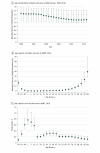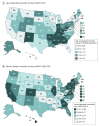Association of Adverse Effects of Medical Treatment With Mortality in the United States: A Secondary Analysis of the Global Burden of Diseases, Injuries, and Risk Factors Study
- PMID: 30657530
- PMCID: PMC6484545
- DOI: 10.1001/jamanetworkopen.2018.7041
Association of Adverse Effects of Medical Treatment With Mortality in the United States: A Secondary Analysis of the Global Burden of Diseases, Injuries, and Risk Factors Study
Abstract
Importance: More than 20 years have passed since the first publication of estimates of the extent of medical harm occurring in hospitals in the United States. Since then, considerable resources have been allocated to improve patient safety, yet policymakers lack a clear gauge of the progress made.
Objectives: To quantify the cause-specific mortality associated with adverse effects of medical treatment (AEMT) in the United States from 1990 to 2016 by age group, sex, and state of residence and to describe trends in types of harm and associations with other diseases and injuries.
Design, setting, and participants: Cohort study using 1990-2016 data on mortality due to AEMT from the Global Burden of Diseases, Injuries, and Risk Factors (GBD) 2016 study, which assessed death certificates of US decedents.
Exposures: Death with International Classification of Diseases (ICD)-coded registration.
Main outcomes and measures: Mortality associated with AEMT. Secondary analyses were performed on all ICD codes in the death certificate's causal chain to describe associations between AEMT and other diseases and injuries.
Results: From 1990 to 2016, there were an estimated 123 603 deaths (95% uncertainty interval [UI], 100 856-163 814 deaths) with AEMT as the underlying cause. Despite an overall increase in the number of deaths due to AEMT over time, the national age-standardized mortality rate due to AEMT decreased by 21.4% (95% UI, 1.3%-32.2%) from 1.46 (95% UI, 1.09-1.76) deaths per 100 000 population in 1990 to 1.15 (95% UI, 1.00-1.60) deaths per 100 000 population in 2016. Men and women had similar rates of AEMT mortality, and those 70 years or older had mortality rates nearly 20-fold greater compared with those aged 15 to 49 years (mortality rate in 2016 for both sexes, 7.93 [95% UI, 7.23-11.45] per 100 000 population for those aged ≥70 years vs 0.38 [95% UI, 0.34-0.43] per 100 000 population for those aged 15-49 years). Per 100 000 population, California had the lowest age-standardized AEMT mortality rate at 0.84 deaths (95% UI, 0.57-1.47 deaths), whereas Mississippi had the highest mortality rate at 1.67 deaths (95% UI, 1.19-2.03 deaths). Surgical and perioperative events were the most common subtype of AEMT, accounting for 63.6% of all deaths for which an AEMT was identified as the underlying cause.
Conclusions and relevance: This study's findings suggest a modest reduction in the mortality rate associated with AEMT in the United States from 1990 to 2016 while also observing increased mortality associated with advancing age and noted geographic variability. The annual GBD releases may allow for tracking of the burden of AEMT in the United States.
Conflict of interest statement
Figures



Similar articles
-
Global Incidence and Mortality Trends due to Adverse Effects of Medical Treatment, 1990-2017: A Systematic Analysis from the Global Burden of Diseases, Injuries and Risk Factors Study.Cureus. 2020 Mar 14;12(3):e7265. doi: 10.7759/cureus.7265. Cureus. 2020. PMID: 32195071 Free PMC article.
-
Changes in the US Burden of Chronic Kidney Disease From 2002 to 2016: An Analysis of the Global Burden of Disease Study.JAMA Netw Open. 2018 Nov 2;1(7):e184412. doi: 10.1001/jamanetworkopen.2018.4412. JAMA Netw Open. 2018. PMID: 30646390 Free PMC article.
-
Trends and Patterns of Differences in Chronic Respiratory Disease Mortality Among US Counties, 1980-2014.JAMA. 2017 Sep 26;318(12):1136-1149. doi: 10.1001/jama.2017.11747. JAMA. 2017. PMID: 28973621 Free PMC article.
-
The global burden of ischemic stroke: findings of the GBD 2010 study.Glob Heart. 2014 Mar;9(1):107-12. doi: 10.1016/j.gheart.2014.01.001. Glob Heart. 2014. PMID: 25432120 Review.
-
Use of population data for assessing trends in work-related asthma mortality.Curr Opin Allergy Clin Immunol. 2019 Apr;19(2):98-104. doi: 10.1097/ACI.0000000000000508. Curr Opin Allergy Clin Immunol. 2019. PMID: 30601151 Free PMC article. Review.
Cited by
-
Development of the German version of the patient safety climate inventory to the Austrian context.BMJ Open. 2022 Feb 16;12(2):e049270. doi: 10.1136/bmjopen-2021-049270. BMJ Open. 2022. PMID: 35172993 Free PMC article.
-
The Safety Action Feedback and Engagement (SAFE) Loop: Initial Testing and Refinement of a Novel Intervention to Enhance Hospital Incident Reporting and Patient Safety.medRxiv [Preprint]. 2025 Jun 6:2025.06.03.25328744. doi: 10.1101/2025.06.03.25328744. medRxiv. 2025. PMID: 40502590 Free PMC article. Preprint.
-
Implementing Pharmacogenomics Testing: Single Center Experience at Arkansas Children's Hospital.J Pers Med. 2021 May 11;11(5):394. doi: 10.3390/jpm11050394. J Pers Med. 2021. PMID: 34064668 Free PMC article.
-
Metabolomics and the Multi-Omics View of Cancer.Metabolites. 2022 Feb 7;12(2):154. doi: 10.3390/metabo12020154. Metabolites. 2022. PMID: 35208228 Free PMC article. Review.
-
Mortality and years of life lost related to adverse drug events in Brazil.Rev Saude Publica. 2024 May 13;58:20. doi: 10.11606/s1518-8787.2024058005458. eCollection 2024. Rev Saude Publica. 2024. PMID: 38747868 Free PMC article.
References
-
- Kohn LT, Corrigan JM, Donaldson MS. To Err Is Human: Building a Safer Health System. Washington, DC: National Academies Press; 1999. - PubMed
-
- Institute for Health Care Improvement. Protecting 5 million lives from harm. http://www.ihi.org/Engage/Initiatives/Completed/5MillionLivesCampaign/Pa.... Accessed November 18, 2016.

